View in other NatureServe Network Field Guides
NatureServe
Montana
Utah
Wyoming
Idaho
Wisconsin
British Columbia
South Carolina
Yukon
California
New York
Lupine Blue - Icaricia lupini
Native Species
Global Rank:
G5
State Rank:
S5
Agency Status
USFWS:
USFS:
BLM:
External Links
General Description
[From Ferris and Brown 1981; Scott 1986; Opler and Wright 1999; Glassberg 2001; Pyle 2002] Forewing 1.1-1.4 cm. Uppersurface with black borders and marginal blackish band; male deep blue to greenish blue, female brown, sometimes with orange along veins, to mostly blue-green; usually with black spot in forewing disk, black scaling interior to orange lunules in hindwing, orange lunules with black marginal spots or borders. Undersurface variable but usually off-white with pattern of black spots, hindwing with submarginal orange and metallic aurora.
Phenology
Several flights, March to July most of range; one flight, late June to mid-August in the Sierra Nevada (Scott 1986). Mainly March to September (Glassberg 2001). Early May to mid-September in Colorado (Scott and Scott 1978), late May to early August in Oregon and Washington (Pyle 2002), mid-May to early August in Oregon (Warren 2005), mid-May to mid-August in British Columbia (Guppy and Shepard 2001).
Diagnostic Characteristics
Best determined by a combination of the uppersurface with relatively broad black borders and marginal blackish band, black scaling interior to orange lunules in hindwing, orange lunules edged with black spots on the outside; undersurface variable but usually off-white with pattern of black spots, hindwing with submarginal orange and metallic aurora.
Species Range
Montana Range
Range Descriptions

 Native
Native
Range Comments
Uncertain due to similarity with Plebejus acmon and ongoing taxonomic revision (Glassberg 2001; Pyle 2002; Warren 2005). Southern British Columbia, Alberta, Saskatchewan south to northern Baja California and mainland Mexico, east to western Great Plains in the western Dakota to western Texas (Opler and Wright 1999); the lutzi subspecies 1310 m to 3810 m elevation in Colorado (Brown 1957; Scott and Scott 1978; Ferris and Brown 1981); 274 m to 2438 m elevation in Oregon (Warren 2005). In Montana, reported across the state in at least 16 counties (Kohler 1980; Stanford and Opler 1993; FLMNH Lepidopterists' Society database) to at least 2804 m elevation.
Observations in Montana Natural Heritage Program Database
Number of Observations: 27
(Click on the following maps and charts to see full sized version)
Map Help and Descriptions
Relative Density
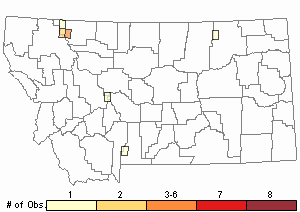
Recency
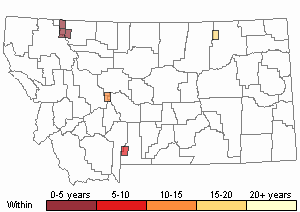
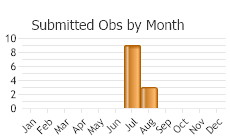
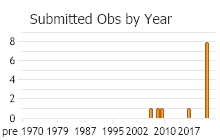
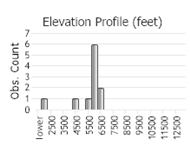 (Observations spanning multiple months or years are excluded from time charts)
(Observations spanning multiple months or years are excluded from time charts)
Migration
Non-migratory.
Habitat
Oak woodland, chaparral, sagebrush steppe, rocky slopes, roadsides, weedy fields, above treeline in alpine terrain (Scott 1986; Opler and Wright 1999; Glassberg 2001; Pyle 2002). In the Greater Yellowstone Ecosystem, reported from xeric montane meadows dominated by sagebrush (Debinski et al. 2013).
Food Habits
Larval food plants include several species of Eriogonum, also Lotus in captivity (Scott 1986, 1992, 2006; Pyle 2002; Warren 2005; James and Nunnallee 2011). Adults feed on flower nectar (including Achillea, Astragalus, Berteroa, Ceanothus, Cerastium, Chrysothamnus, Clematis, Erigeron, Eriogonum, Glycyrrhiza, Gutierrezia, Heterotheca, Melilotus, Psoralea, Senecio, Solidago, Symphyotrichum, Taraxacum, Thelesperma), dung, and mud (Pyle 2002; Scott 2014).
Reproductive Characteristics
Females lay eggs singly and primarily on host plant flowers, infrequently on undersides of leaves near inflorescence (Scott 1986, 2006). Eggs hatch in about 7 days (depending on temperature), reach L3 instar in about 15 days post egg-hatch, overwinter (diapause) as L2 or L3 instar. Post-diapause larvae reach L4 in about 27 days, pupate in debris at base of host plant. Larvae solitary, build no nest, are tended by ants (Formica neogagates and Tapinoma sessile in Washington), L1 and L2 instars feed on host plant leaves, flowers, seeds (Scott 1979; James and Nunnallee 2011). Males patrol throughout the day near host plants in search of females (Scott 1975b, 1986).
Stewardship Responsibility
References
- Literature Cited AboveLegend:
 View Online Publication
View Online Publication Brown, F.M. 1957. Colorado Butterflies. Proceedings; Numbers Three through Seven. Denver Museum of Natural History, Denver, Co.
Brown, F.M. 1957. Colorado Butterflies. Proceedings; Numbers Three through Seven. Denver Museum of Natural History, Denver, Co. Debinski, D.M., J.C. Caruthers, D. Cook, J. Crowley, and H. Wickham. 2013. Gradient-based habitat affinities predict species vulnerability to drought. Ecology 94(5): 1036-1045.
Debinski, D.M., J.C. Caruthers, D. Cook, J. Crowley, and H. Wickham. 2013. Gradient-based habitat affinities predict species vulnerability to drought. Ecology 94(5): 1036-1045. Ferris, C.D. and F.M. Brown (eds). 1981. Butterflies of the Rocky Mountains. Univ. of Oklahoma Press. Norman. 442 pp.
Ferris, C.D. and F.M. Brown (eds). 1981. Butterflies of the Rocky Mountains. Univ. of Oklahoma Press. Norman. 442 pp. Glassberg, J. 2001. Butterflies through Binoculars: A Field Guide to the Butterflies of Western North America. Oxford University Press.
Glassberg, J. 2001. Butterflies through Binoculars: A Field Guide to the Butterflies of Western North America. Oxford University Press. Guppy, C.S. and J.H. Shepard. 2001. Butterflies of British Columbia: including western Alberta, southern Yukon, the Alaska Panhandle, Washington, northern Oregon, northern Idaho, northwestern Montana. UBC Press (Vancouver, BC) and Royal British Columbia Museum (Victoria, BC). 414 pp.
Guppy, C.S. and J.H. Shepard. 2001. Butterflies of British Columbia: including western Alberta, southern Yukon, the Alaska Panhandle, Washington, northern Oregon, northern Idaho, northwestern Montana. UBC Press (Vancouver, BC) and Royal British Columbia Museum (Victoria, BC). 414 pp. James, D.G. and D. Nunnallee. 2011. Life histories of Cascadia butterflies. Corvallis, OR: Oregon State University Press. 447 p.
James, D.G. and D. Nunnallee. 2011. Life histories of Cascadia butterflies. Corvallis, OR: Oregon State University Press. 447 p. Kohler, S. 1980. Checklist of Montana Butterflies (Rhopalocera). Journal of the Lepidopterists' Society 34(1): 1-19.
Kohler, S. 1980. Checklist of Montana Butterflies (Rhopalocera). Journal of the Lepidopterists' Society 34(1): 1-19. Opler, P.A. and A.B. Wright. 1999. A field guide to western butterflies. Second edition. Peterson Field Guides. Houghton Mifflin Company, Boston, Massachusetts. 540 pp.
Opler, P.A. and A.B. Wright. 1999. A field guide to western butterflies. Second edition. Peterson Field Guides. Houghton Mifflin Company, Boston, Massachusetts. 540 pp. Pyle, R.M. 2002. The butterflies of Cascadia: a field guide to all the species of Washington, Oregon, and surrounding territories. Seattle Audubon Society, Seattle, Washington. 420 pp.
Pyle, R.M. 2002. The butterflies of Cascadia: a field guide to all the species of Washington, Oregon, and surrounding territories. Seattle Audubon Society, Seattle, Washington. 420 pp. Scott, J.A. 1975b. Mate-locating behavior of western North American butterflies. Journal of Research on the Lepidoptera 14:1-40.
Scott, J.A. 1975b. Mate-locating behavior of western North American butterflies. Journal of Research on the Lepidoptera 14:1-40. Scott, J.A. 1979. Hibernal diapause of North American Papilionoidea and Hesperioidea. Journal of Research on the Lepidoptera 18(3): 171-200.
Scott, J.A. 1979. Hibernal diapause of North American Papilionoidea and Hesperioidea. Journal of Research on the Lepidoptera 18(3): 171-200. Scott, J.A. 1986. The butterflies of North America: a natural history and field guide. Stanford University Press, Stanford, California.
Scott, J.A. 1986. The butterflies of North America: a natural history and field guide. Stanford University Press, Stanford, California. Scott, J.A. 1992. Hostplant records for butterflies and skippers (mostly from Colorado) 1959-1992, with new life histories and notes on oviposition, immatures, and ecology. Papilio new series #6. 185 p.
Scott, J.A. 1992. Hostplant records for butterflies and skippers (mostly from Colorado) 1959-1992, with new life histories and notes on oviposition, immatures, and ecology. Papilio new series #6. 185 p. Scott, J.A. 2006. Butterfly hostplant records, 1992-2005, with a treatise on the evolution of Erynnis, and a note on new terminology for mate-locating behavior. Papilio new series #14. 74 p.
Scott, J.A. 2006. Butterfly hostplant records, 1992-2005, with a treatise on the evolution of Erynnis, and a note on new terminology for mate-locating behavior. Papilio new series #14. 74 p. Scott, J.A. 2014. Lepidoptera of North America 13. Flower visitation by Colorado butterflies (40,615 records) with a review of the literature on pollination of Colorado plants and butterfly attraction (Lepidoptera: Hersperioidea and Papilionoidea). Contributions of the C.P. Gillette Museum of Arthopod Diversity. Fort Collins, CO: Colorado State University. 190 p.
Scott, J.A. 2014. Lepidoptera of North America 13. Flower visitation by Colorado butterflies (40,615 records) with a review of the literature on pollination of Colorado plants and butterfly attraction (Lepidoptera: Hersperioidea and Papilionoidea). Contributions of the C.P. Gillette Museum of Arthopod Diversity. Fort Collins, CO: Colorado State University. 190 p. Scott, J.A. and G.R. Scott. 1978. Ecology and distribution of the butterflies of southern central Colorado. Journal of Research on the Lepidoptera 17(2): 73-128.
Scott, J.A. and G.R. Scott. 1978. Ecology and distribution of the butterflies of southern central Colorado. Journal of Research on the Lepidoptera 17(2): 73-128. Stanford, R.E. and P.A. Opler. 1993. Atlas of western USA butterflies: including adjacent parts of Canada and Mexico. Unpubl. Report. Denver and Fort Collins, Colorado 275 pp.
Stanford, R.E. and P.A. Opler. 1993. Atlas of western USA butterflies: including adjacent parts of Canada and Mexico. Unpubl. Report. Denver and Fort Collins, Colorado 275 pp. Warren, A.D. 2005. Lepidoptera of North America 6: Butterflies of Oregon, their taxonomy, distribution, and biology. Contributions of the C. P. Gillette Museum of Arthropod Diversity, Colorado State University. Fort Collins, Colorado. 406 pp.
Warren, A.D. 2005. Lepidoptera of North America 6: Butterflies of Oregon, their taxonomy, distribution, and biology. Contributions of the C. P. Gillette Museum of Arthropod Diversity, Colorado State University. Fort Collins, Colorado. 406 pp.
- Additional ReferencesLegend:
 View Online Publication
View Online Publication
Do you know of a citation we're missing? Allen, T.J., J.P. Brock, and J. Glassberg. 2005. Caterpillars in the field and garden: a field guide to the butterfly caterpillars of North America. Oxford University Press.
Allen, T.J., J.P. Brock, and J. Glassberg. 2005. Caterpillars in the field and garden: a field guide to the butterfly caterpillars of North America. Oxford University Press. Brock, J.P. and K. Kaufman. 2003. Kaufman Field Guide to Butterflies of North America. Houghton Mifflin Company, New York, NY 284 pp.
Brock, J.P. and K. Kaufman. 2003. Kaufman Field Guide to Butterflies of North America. Houghton Mifflin Company, New York, NY 284 pp. Caruthers, J.C., and D. Debinski. 2006. Montane meadow butterfly species distributions in the Greater Yellowstone Ecosystem. University of Wyoming National Park Service Research Center Annual Report, 2006. Vol. 30, Art. 14. 85-96.
Caruthers, J.C., and D. Debinski. 2006. Montane meadow butterfly species distributions in the Greater Yellowstone Ecosystem. University of Wyoming National Park Service Research Center Annual Report, 2006. Vol. 30, Art. 14. 85-96. Hendricks, P. and M. Roedel. 2001. A faunal survey of the Centennial Valley Sandhills, Beaverhead County, Montana. Report to the U.S. Bureau of Land Management and U.S. Fish and Wildlife Service. Montana Natural Heritage Program, Helena, MT. 44 p.
Hendricks, P. and M. Roedel. 2001. A faunal survey of the Centennial Valley Sandhills, Beaverhead County, Montana. Report to the U.S. Bureau of Land Management and U.S. Fish and Wildlife Service. Montana Natural Heritage Program, Helena, MT. 44 p. Poole, R.W. and P. Gentili, and R.E. Lewis (eds.). 1996. Nomina Insecta Nearctica: a checklist of the insects of North America. Volume 3 (Diptera, Lepidoptera, Siphonaptera). Entomological Information Services, Rockville, MD.
Poole, R.W. and P. Gentili, and R.E. Lewis (eds.). 1996. Nomina Insecta Nearctica: a checklist of the insects of North America. Volume 3 (Diptera, Lepidoptera, Siphonaptera). Entomological Information Services, Rockville, MD.
- Web Search Engines for Articles on "Lupine Blue"
- Additional Sources of Information Related to "Insects"





